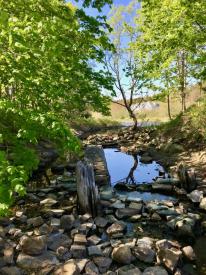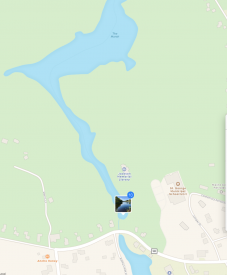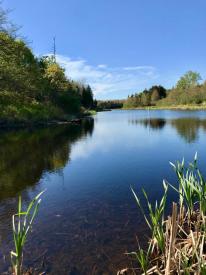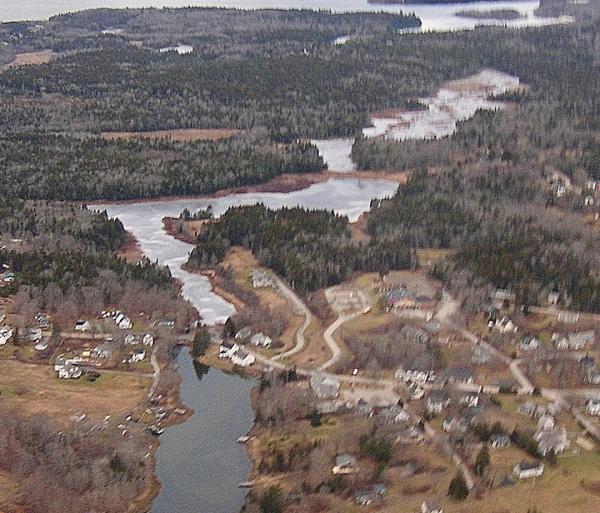Tenants Harbor Marsh
Introduction



The Marsh and Ripley Creek are located on the west side of Tenants Harbor and have a long history as ecologically rich areas and sources for recreation and commerce.
Visitors can observe the remains of a dam that raised the level of the creek and marsh to support a variety of fish and other animal life. There is parking adjacent to this site just off rte 131.
A beaver lodge can be seen from the end of the Leslie Hyde Memorial Trail. Parking is available at the library.
The Marsh was once rich with alewives; an important food source in the ecosystem. The Conservation Commission and the St. George School have worked together to study the marsh and to restore the alewife population.

Origins of the Project
The Conservation Commission of St. George took on the project of restoring the alewife run into the marsh in Tenants Harbor. John Shea had been promoting the idea and convinced the state’s Department of Marine Resources (DMR) to begin stocking the marsh with alewives in 2009, to once again establish a run of 3000-5000 fish into the Marsh.
Historically, locals nearby Ripley Creek would first notice the returning fish because the sky would be filled with birds coming to feed on the fish when the springtime run began. St. George Middle Level Science students have collected oral histories from community members telling how the fish came up Ripley Creek and of the anticipation and activity the run prompted. Inter-generational family stories came to light. The run had a history of small harvests for use as bait until the mid-1980’s, when the annual run collapsed.
Fish Passage Issues
Route 131 passing over Ripley Creek first had granite abutments and a short bridge over the stream leading to the marsh. Migratory species passed over the gravel bottom. A new round steel culvert was put in by DOT in 1970. It replaced the previous structure and was higher in elevation so that it was above sea level. The alewives will swim up steep and shallow streams but not jump. Access to breeding habitat in the marsh was impeded, although adults were observed returning the following springs and some harvesting continued.
Stocking the Marsh
DMR decided to approve the stocking based on the history of the runs. Starting in 2009, DMR collected migrating adult alewives from elsewhere in the state and loaded 900 fish in a tank on a truck for release into the marsh, which students of the St. George School and the Herring Gut Learning Center were delighted to help with. Typically, herring return to the same bodies of water each spring to breed. Juvenile fish spend their first several months in that water body and become “imprinted” with this specific pond or lake or marsh and will return three to four years later when they are mature and begin their own migratory breeding cycle. The offspring of these stocked fish would be natives of our marsh and re-establish our run. The stocking was done for four years. If 3000 fish were to be re-established in the marsh, each producing 1500 eggs, there would be many juveniles going back to coastal nursery grounds in the Gulf of Maine. The alewives have been important for bait, food, and support of the ecosystem of the Gulf of Maine particularly cod and other fin-fish. As communities along the St. George River work to improve fish passage enhancing their local runs, the increasingly abundant alewife population in the St. George River watershed can be sustainably harvested as fresh bait, and as a potential frozen bait.
History of a New Fish Friendly Culvert
As conservation organizations pursued restoration efforts across the state, the Maine Department of Transportation (MDOT) began to realize some of their culverts were stopping river herring from getting to their breeding ponds. Because of budget constraints, the Ripley Creek culvert was not enough of a priority to replace unless it was rusted out. There were several meetings at the marsh with thirty people including NOAA, MDOT, The Nature Conservancy, Alewife Harvesters, Knox-Lincoln Water and Soil Conservation, and many interested local people to see what could be done. Some grant money was raised, a project manager was found, and MDOT designed a fish friendly culvert (also suitable for other migratory fish species and a 100 year flood level). The culvert was completed in 2015.
St George School does Research in the Marsh and Improves Fish Passage in the Stream
After the stocking and installation of the fish-friendly culvert, the newly reorganized Municipal School Unit of St George School began a study of water flows coming out of the marsh and into the culvert, since the new culvert design was based on the guaged flow of streams of similar nature, but out of state! Learning about the history of our run and the stream habitat itself also began. The students realized that pools where fish could rest and gather before continuing up streams were typical, and improved the pool upstream of the culvert, as well as directing the flow of water into and out of the pool. During May of the most recent springs, students have tailored several different “fishway” designs for fish to have a way to swim up over the remains of the dam, extensively documenting their work for the town (2016, 2019). Recently in 2020, a consultant who does restoration projects in New England commented the work was excellent.
A Lack of Returning Fish
In May of 2016, after an absence of around 30 years, the first several alewives were seen coming back to the marsh. It was very exciting. That spring, about 30, perhaps 40 alewives were observed in the culvert between tides. Under the permit held by the Conservation Commission, students netted 10 alewives and placed them in the marsh. Perhaps others made it into the marsh, swimming on the tide. In 2018, only two alewives were observed swimming upstream of the culvert, but below the dam, and they were placed into the marsh. In 2019, no returning alewives were observed despite our repeated observation efforts.
The problem of the poor return has been considered by many biologists, DMR, and alewive specialists. There were some very dry summers where other alewife projects saw access into water bodies for the adults and getting out of them for the juveniles diminished due to lower water levels.
During that time, an idea from the students was to investigate salinity as they observed successive ‘Nor Easters in March 2018 bring flood tides over the dam. In 2018-2019, students built and deployed a remote salinity meter to collect data on an unknown variable. They also designed and carried out an investigation of the effects of salinity on alewife fry.
After a paddle in September of 2019, students summarized their findings to date, highlighting depth and salinity measurements and classroom activities from the previous spring. They learned the marsh is uniformly shallow and during that September, the marsh had low levels of salinity throughout. Analysis of August, 2019 salinity data was included in the findings and showed the impact of repeated flooding tides in the marsh over the month. Results of the alewife fry investigation and analysis of initial salinity meter data was also presented. The report also includes some documented history of the dam and student reflections for inquiry in the future.
Future Work
Dr Karen Wilson, a limnologist and research professor at University of Southern Maine who was contacted for consultation, suggested there could be temperature fluctuations and lack of zooplankton, feed, for the juvenile alewives that would decrease their survival. She would like to come and see what the students are doing, but the school closure during the Covid-19 Pandemic has put this on hold. Before the closure, students had begun building a second remote salinity probe to deploy in the marsh that will be able to measure salinity, temperature and oxygen levels. A classroom investigation of salinity effects on zooplankton was also in the works. Other students had indicated interest in building a tide gauge for gathering data in our local harbor and monitoring tidal events.
We know that working together to do challenging things is worthwhile. Being good stewards of our resources is the legacy we leave to our youth. The community involvement is so strong here with so many diverse interests in support of the project, that it is still possible to have an alewife run once again.
